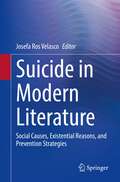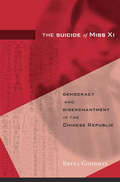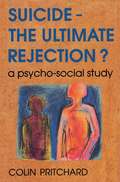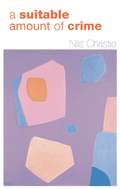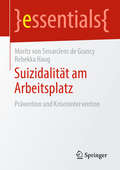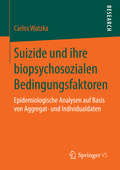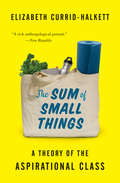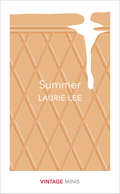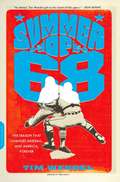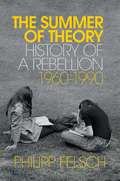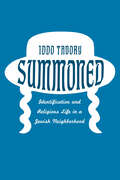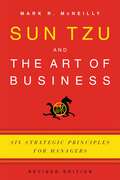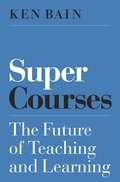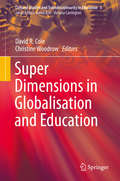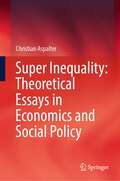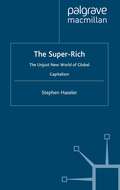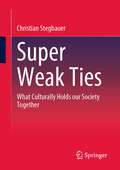- Table View
- List View
Suicide in Modern Literature: Social Causes, Existential Reasons, and Prevention Strategies
by Josefa Ros VelascoThis book analyzes the social and contextual causes of suicide, the existential and philosophical reasons for committing suicide, and the prevention strategies that modern fictional literature places at our disposal. They go through the review of Modern fictional literature, in the American and European geographical framework, following the rationales that modern literature based on fiction can serve the purpose of understanding better the phenomenon of suicide, its most inaccessible impulses, and that has the potential to prevent suicide.From the turn of the 20th century to the present, debates over the meaning of suicide became a privileged site for efforts to discover the reasons why people commit suicide and how to prevent this behavior. Since the French sociologist and philosopher Émile Durkheim published his study Suicide: A Study in Sociology in 1897, a reframing of suicide took place, giving rise to a flourishing group of researchers and authors devoting their efforts to understand better the causes of suicide and to the formation of suicide prevention organizations. A century later, we still keep on trying to reach such an understanding of suicide, the nature, and nuances of its modern conceptualization, to prevent suicidal behaviors.The question of what suicide means in and for modernity is not an overcome one. Suicide is an act that touches all of our lives and engages with the incomprehensible and unsayable. Since the turn of the millennium, a fierce debate about the state’s role in assisted suicide has been adopted. Beyond the discussion as to whether physicians should assist in the suicide of patients with unbearable and hopeless suffering, the scope of the suicidal agency is much broader concerning general people wanting to die.
The Suicide of Miss Xi: Democracy and Disenchantment in the Chinese Republic
by Bryna GoodmanA suicide scandal in Shanghai reveals the social fault lines of democratic visions in China’s troubled Republic in the early 1920s. On September 8, 1922, the body of Xi Shangzhen was found hanging in the Shanghai newspaper office where she worked. Although her death took place outside of Chinese jurisdiction, her US–educated employer, the social activist Tang Jiezhi, was kidnapped by Chinese authorities and put on trial. As scandal rocked the city, novelists, filmmakers, suffragists, reformers, and even a founding member of the Chinese Communist Party seized upon the case as emblematic of deeper social problems. Xi’s family claimed that Tang had pressured her to be his concubine; his conviction instead for financial fraud only stirred further controversy. The creation of a republic ten years earlier had unleashed a powerful vision of popular sovereignty and a view of citizenship founded upon science, equality, and family reform. But, Bryna Goodman shows, after the suppression of the first Chinese parliament, efforts at urban liberal democracy dissolved in a flash of speculative finance and the suicide of an educated, working “new woman.” In yet another blow, Tang’s trial exposed the frailty of legal mechanisms in a political landscape fragmented by warlords and enclaves of foreign colonial rule. The Suicide of Miss Xi opens a window onto how urban Chinese in the first part of the twentieth century navigated China’s early passage through democratic populism, in an ill-fated moment of possibility between empire and party dictatorship. Xi Shangzhen became a symbol of the failures of the Chinese Republic as well as the broken promises of citizen’s rights, gender equality, and financial prosperity betokened by liberal democracy and capitalism.
Suicide - The Ultimate Rejection? (UK Higher Education OUP Humanities & Social Sciences Health & Social Welfare)
by N A PritchardSuicide - The Ultimate Rejection? is an interdisciplinary text based on Colin Pritchard's first-hand experience both as a practising psychiatric social worker and social researcher. It provides an analysis of current research on suicide, exploring possible 'causes' and how best to intervene, and makes the case for a science based practice 'art'. International rates of suicide are examined as the author looks at suicide in a cross-cultural context showing how it is differently understood in different ethnic groups, reflecting various degrees of stigma. He argues for greater recognition of these key differences between cultures and ethnic groups, and shows how important they can be to our understanding and intervention.Suicide - The Ultimate Rejection? explores the concepts of prediction and prevention and asks how the current health and community services might work to reduce the number of suicides in line with the targets set by the government's Health of the Nation. Different approaches to intervention and treatment are considered, with emphasis on those which research has shown to be the most promising. Special attention is given to the families of the victim, and in the final pages a wider view of suicide which includes euthanasia is explored. Using new research, Colin Pritchard examines the practical and moral issues raised by euthanasia.Suicide will be of interest to students of social work, psychiatric nursing, health visiting and medicine, as well as health professionals and counsellors.
Suicide Voices: Labour Trauma in France (Studies in Modern and Contemporary France #8)
by Sarah WatersThis book examines the phenomenon of work suicides in France and asks why, at the present historical juncture, conditions of work can push individuals to take their own lives. During the 2000s, France experienced what commentators have described as a ‘suicide epidemic’, whereby increasing numbers of workers in the face of extreme pressures of work, chose to kill themselves. The book analyses a corpus of testimonial material linked to 66 suicide cases across three large French companies during the period from 2005 to 2015. It aims to consider what the extreme and subjective act of self-killing, narrated in suicide letters, can tell us about the contemporary economic order and its impact on flesh and blood bodies. What do rising work-related suicides reveal about conditions of human labour in the twenty-first century? Does neoliberal economics condition a desire for suicide? How do suicidal individuals describe the causes and motivations of their act? Combining critical perspectives from sociology, history, testimony studies, economics, cultural studies and public health, the book raises critical questions about the human costs of the shift to a finance-driven neoliberal order and its everyday effects within the French workplace.
A Suitable Amount of Crime
by Nils ChristieCrime and punishment are social and cultural manifestations; they are closely bound up with people's perceptions of morality, norms and values. In this book, Nils Christie argues that crime is a fluid and shallow concept - acts that could be construed as criminal are unlimited and crime is therefore in endless supply. It should not be forgotten that there are alternatives, both in the definition of crime, and in responses to it. A Suitable Amount of Crime looks at the great variations between countries over what are considered 'unwanted acts', how many are constructed as criminal and how many are punished. It explains the differences between eastern and western Europe, between the USA and the rest of the world. The author laments the size of prison populations in countries with large penal sectors, and asks whether the international community has a moral obligation to 'shame' states that are punitive in the extreme.The book is written in an engaging and easily accessible style that will appeal to anyone interested in understanding contemporary problems of crime and punishment.
A Suitable Amount of Crime
by Nils ChristieCrime and punishment are social and cultural manifestations; they are closely bound up with people's perceptions of morality, norms and values. In this book, Nils Christie argues that crime is a fluid and shallow concept - acts that could be construed as criminal are unlimited and crime is therefore in endless supply. It should not be forgotten that there are alternatives, both in the definition of crime, and in responses to it. A Suitable Amount of Crime looks at the great variations between countries over what are considered 'unwanted acts', how many are constructed as criminal and how many are punished. It explains the differences between eastern and western Europe, between the USA and the rest of the world. The author laments the size of prison populations in countries with large penal sectors, and asks whether the international community has a moral obligation to 'shame' states that are punitive in the extreme.The book is written in an engaging and easily accessible style that will appeal to anyone interested in understanding contemporary problems of crime and punishment.
Suizidalität am Arbeitsplatz: Prävention und Krisenintervention (essentials)
by Moritz von Senarclens de Grancy Rebekka HaugDas essential bespricht Aspekte des Suizidrisikos im Unternehmen und stellt Präventionsmaßnahmen und Maßnahmen zur Krisenintervention vor. Der Autor und die Autorin führen Techniken wie das Containing ein und diskutieren den Umgang mit emotionalen Reaktionen wie Hoffnungslosigkeit, Ohnmachtsgefühle oder Autoaggressivität. Psychoanalytisches Hintergrundwissen und ein kulturgeschichtlicher Überblick zum Suizid bereichern den Band. Besondere praxisrelevante Aspekte sowie rechtliche Fragen zum Suizid am Arbeitsplatz runden die Einführung ab.
Suizide und ihre biopsychosozialen Bedingungsfaktoren: Epidemiologische Analysen auf Basis von Aggregat- und Individualdaten
by Carlos WatzkaCarlos Watzka aktualisiert und vertieft die Forschung zu Risikofaktoren für Selbsttötungen auf individueller und kollektiver Ebene mittels multivariater quantitativer Analysen und schließt damit an seine Pilotstudie „Sozialstruktur und Suizid (2008)“ an. So kann ein neu erstelltes Erklärungsmodell auf Basis von Bezirksdaten der Jahre 2001-2009 mehr als 60 % der regionalen Schwankungen der Suizidraten in Österreich auf den Einfluss von 11 Parametern zurückführen, zu denen Alters-, Familien-, Wohn- und Erwerbsstruktur, Einkommens- und Bildungsniveau, aber auch der Grad der medizinischen, psychotherapeutischen und psychosozialen Versorgung sowie Topographie und Landschaftsstruktur zählen. Hochrisikopopulationen für Suizide werden damit präziser identifizierbar und so auch die Wissensbasis für gezieltere Präventionsaktivitäten bedeutend erweitert.
The Sum of Small Things: A Theory of the Aspirational Class
by Elizabeth Currid-HalkettHow the leisure class has been replaced by a new elite, and how their consumer habits affect us allIn today’s world, the leisure class has been replaced by a new elite. Highly educated and defined by cultural capital rather than income bracket, these individuals earnestly buy organic, carry NPR tote bags, and breast-feed their babies. They care about discreet, inconspicuous consumption—like eating free-range chicken and heirloom tomatoes, wearing organic cotton shirts and TOMS shoes, and listening to the Serial podcast. They use their purchasing power to hire nannies and housekeepers, to cultivate their children’s growth, and to practice yoga and Pilates. In The Sum of Small Things, Elizabeth Currid-Halkett dubs this segment of society “the aspirational class” and discusses how, through deft decisions about education, health, parenting, and retirement, the aspirational class reproduces wealth and upward mobility, deepening the ever-wider class divide. Exploring the rise of the aspirational class, Currid-Halkett considers how much has changed since the 1899 publication of Thorstein Veblen’s Theory of the Leisure Class. In that inflammatory classic, which coined the phrase “conspicuous consumption,” Veblen described upper-class frivolities: men who used walking sticks for show, and women who bought silver flatware despite the effectiveness of cheaper aluminum utensils. Now, Currid-Halkett argues, the power of material goods as symbols of social position has diminished due to their accessibility. As a result, the aspirational class has altered its consumer habits away from overt materialism to more subtle expenditures that reveal status and knowledge. And these transformations influence how we all make choices. With a rich narrative and extensive interviews and research, The Sum of Small Things illustrates how cultural capital leads to lifestyle shifts and what this forecasts, not just for the aspirational class but for everyone.
Summer: Vintage Minis (Vintage Minis)
by Laurie LeeHow do you remember the summers of your childhood? For Laurie Lee they were flower-crested, heady, endless days. Here is an evocation of summer like no other – a remote valley filled with the scent of hay, jazzing wasps, blackberries plucked and gobbled, and games played until the last drop of dusk. Lee’s joyful and stirring writing captures the very essence of England’s golden season. Selected from the book Cider with Rosie by Laurie Lee VINTAGE MINIS: GREAT MINDS. BIG IDEAS. LITTLE BOOKS.A series of short books by the world’s greatest writers on the experiences that make us human Also in the Vintage Minis series: Liberty by Virginia Woolf Eating by Nigella Lawson Swimming by Roger DeakinDrinking by John Cheever
Summer of '68: The Season That Changed Baseball--and America--Forever
by Tim WendelThe extraordinary story of the 1968 baseball season—when the game was played to perfection even as the country was being pulled apart at the seamsFrom the beginning, '68 was a season rocked by national tragedy and sweeping change. Opening Day was postponed and later played in the shadow of Martin Luther King, Jr.'s funeral. That summer, as the pennant races were heating up, the assassination of Robert Kennedy was later followed by rioting at the Democratic National Convention in Chicago. But even as tensions boiled over and violence spilled into the streets, something remarkable was happening in major league ballparks across the country. Pitchers were dominating like never before, and with records falling and shut-outs mounting, many began hailing '68 as “The Year of the Pitcher.”In Summer of '68, Tim Wendel takes us on a wild ride through a season that saw such legends as Bob Gibson, Denny McLain, Don Drysdale, and Luis Tiant set new standards for excellence on the mound, each chasing perfection against the backdrop of one of the most divisive and turbulent years in American history. For some players, baseball would become an insular retreat from the turmoil encircling them that season, but for a select few, including Gibson and the defending champion St. Louis Cardinals, the conflicts of '68 would spur their performances to incredible heights and set the stage for their own run at history.Meanwhile in Detroit—which had burned just the summer before during one of the worst riots in American history—'68 instead found the city rallying together behind a colorful Tigers team led by McLain, Mickey Lolich, Willie Horton, and Al Kaline. The Tigers would finish atop the American League, setting themselves on a highly anticipated collision course with Gibson's Cardinals. And with both teams' seasons culminating in a thrilling World Series for the ages—one team playing to establish a dynasty, the other fighting to help pull a city from the ashes—what ultimately lay at stake was something even larger: baseball's place in a rapidly changing America that would never be the same.In vivid, novelistic detail, Summer of '68 tells the story of this unforgettable season—the last before rule changes and expansion would alter baseball forever—when the country was captivated by the national pastime at the moment it needed the game most.
The Summer of Theory: History of a Rebellion, 1960-1990
by Philipp Felsch‘Theory’ – a magical glow has emanated from this word since the sixties. Theory was more than just a succession of ideas: it was an article of faith, a claim to truth, a lifestyle. It spread among its adherents in cheap paperbacks and triggered heated debates in seminar rooms and cafés. The Frankfurt School, Structuralism, Post-Structuralism, Adorno, Derrida, Foucault: these and others were the exotic schools and thinkers whose ideas were being devoured by young minds. But where did the fascination for dangerous thoughts come from? In his magnificently written book, Philipp Felsch follows the hopes and dreams of a generation that entered the jungle of difficult texts. His setting is West Germany in the decades from the 1960s to the 1990s: in a world frozen in the Cold War, movement only came from big ideas. It was the time of apocalyptic master thinkers, upsetting reading experiences and glamorous incomprehensibility. As the German publisher Suhrkamp published Adorno’s Minima Moralia and other High Theory works of the Frankfurt School, a small publisher in West Berlin, Merve Verlag, provided readers with a steady stream of the subversive new theory coming out of France. By following the adventures of the publishers who provided the books and the reading communities that consumed and debated them, Philipp Felsch tells the remarkable story of an intellectual revolt when the German Left fell in love with Theory.
Summoned: Identification and Religious Life in a Jewish Neighborhood
by Iddo TavoryOn a typical weekday, men of the Beverly-La Brea Orthodox community wake up early, beginning their day with Talmud reading and prayer at 5:45am, before joining Los Angeles’ traffic. Those who work “Jewish jobs”—teachers, kosher supervisors, or rabbis—will stay enmeshed in the Orthodox world throughout the workday. But even for the majority of men who spend their days in the world of gentiles, religious life constantly reasserts itself. Neighborhood fixtures like Jewish schools and synagogues are always after more involvement; evening classes and prayers pull them in; the streets themselves seem to remind them of who they are. And so the week goes, culminating as the sabbatical observances on Friday afternoon stretch into Saturday evening. Life in this community, as Iddo Tavory describes it, is palpably thick with the twin pulls of observance and sociality. In Summoned, Tavory takes readers to the heart of the exhilarating—at times exhausting—life of the Beverly-La Brea Orthodox community. Just blocks from West Hollywood’s nightlife, the Orthodox community thrives next to the impure sights, sounds, and smells they encounter every day. But to sustain this life, as Tavory shows, is not simply a moral decision they make. To be Orthodox is to be constantly called into being. People are reminded of who they are as they are called upon by organizations, prayer quorums, the nods of strangers, whiffs of unkosher food floating through the street, or the rarer Anti-Semitic remarks. Again and again, they find themselves summoned both into social life and into their identity as Orthodox Jews. At the close of Tavory’s fascinating ethnography, we come away with a better understanding of the dynamics of social worlds, identity, interaction and self—not only in Beverly-La Brea, but in society at large.
Summoned: Identification and Religious Life in a Jewish Neighborhood
by Iddo TavoryOn a typical weekday, men of the Beverly-La Brea Orthodox community wake up early, beginning their day with Talmud reading and prayer at 5:45am, before joining Los Angeles’ traffic. Those who work “Jewish jobs”—teachers, kosher supervisors, or rabbis—will stay enmeshed in the Orthodox world throughout the workday. But even for the majority of men who spend their days in the world of gentiles, religious life constantly reasserts itself. Neighborhood fixtures like Jewish schools and synagogues are always after more involvement; evening classes and prayers pull them in; the streets themselves seem to remind them of who they are. And so the week goes, culminating as the sabbatical observances on Friday afternoon stretch into Saturday evening. Life in this community, as Iddo Tavory describes it, is palpably thick with the twin pulls of observance and sociality. In Summoned, Tavory takes readers to the heart of the exhilarating—at times exhausting—life of the Beverly-La Brea Orthodox community. Just blocks from West Hollywood’s nightlife, the Orthodox community thrives next to the impure sights, sounds, and smells they encounter every day. But to sustain this life, as Tavory shows, is not simply a moral decision they make. To be Orthodox is to be constantly called into being. People are reminded of who they are as they are called upon by organizations, prayer quorums, the nods of strangers, whiffs of unkosher food floating through the street, or the rarer Anti-Semitic remarks. Again and again, they find themselves summoned both into social life and into their identity as Orthodox Jews. At the close of Tavory’s fascinating ethnography, we come away with a better understanding of the dynamics of social worlds, identity, interaction and self—not only in Beverly-La Brea, but in society at large.
Summoned: Identification and Religious Life in a Jewish Neighborhood
by Iddo TavoryOn a typical weekday, men of the Beverly-La Brea Orthodox community wake up early, beginning their day with Talmud reading and prayer at 5:45am, before joining Los Angeles’ traffic. Those who work “Jewish jobs”—teachers, kosher supervisors, or rabbis—will stay enmeshed in the Orthodox world throughout the workday. But even for the majority of men who spend their days in the world of gentiles, religious life constantly reasserts itself. Neighborhood fixtures like Jewish schools and synagogues are always after more involvement; evening classes and prayers pull them in; the streets themselves seem to remind them of who they are. And so the week goes, culminating as the sabbatical observances on Friday afternoon stretch into Saturday evening. Life in this community, as Iddo Tavory describes it, is palpably thick with the twin pulls of observance and sociality. In Summoned, Tavory takes readers to the heart of the exhilarating—at times exhausting—life of the Beverly-La Brea Orthodox community. Just blocks from West Hollywood’s nightlife, the Orthodox community thrives next to the impure sights, sounds, and smells they encounter every day. But to sustain this life, as Tavory shows, is not simply a moral decision they make. To be Orthodox is to be constantly called into being. People are reminded of who they are as they are called upon by organizations, prayer quorums, the nods of strangers, whiffs of unkosher food floating through the street, or the rarer Anti-Semitic remarks. Again and again, they find themselves summoned both into social life and into their identity as Orthodox Jews. At the close of Tavory’s fascinating ethnography, we come away with a better understanding of the dynamics of social worlds, identity, interaction and self—not only in Beverly-La Brea, but in society at large.
Summoned: Identification and Religious Life in a Jewish Neighborhood
by Iddo TavoryOn a typical weekday, men of the Beverly-La Brea Orthodox community wake up early, beginning their day with Talmud reading and prayer at 5:45am, before joining Los Angeles’ traffic. Those who work “Jewish jobs”—teachers, kosher supervisors, or rabbis—will stay enmeshed in the Orthodox world throughout the workday. But even for the majority of men who spend their days in the world of gentiles, religious life constantly reasserts itself. Neighborhood fixtures like Jewish schools and synagogues are always after more involvement; evening classes and prayers pull them in; the streets themselves seem to remind them of who they are. And so the week goes, culminating as the sabbatical observances on Friday afternoon stretch into Saturday evening. Life in this community, as Iddo Tavory describes it, is palpably thick with the twin pulls of observance and sociality. In Summoned, Tavory takes readers to the heart of the exhilarating—at times exhausting—life of the Beverly-La Brea Orthodox community. Just blocks from West Hollywood’s nightlife, the Orthodox community thrives next to the impure sights, sounds, and smells they encounter every day. But to sustain this life, as Tavory shows, is not simply a moral decision they make. To be Orthodox is to be constantly called into being. People are reminded of who they are as they are called upon by organizations, prayer quorums, the nods of strangers, whiffs of unkosher food floating through the street, or the rarer Anti-Semitic remarks. Again and again, they find themselves summoned both into social life and into their identity as Orthodox Jews. At the close of Tavory’s fascinating ethnography, we come away with a better understanding of the dynamics of social worlds, identity, interaction and self—not only in Beverly-La Brea, but in society at large.
Summoned: Identification and Religious Life in a Jewish Neighborhood
by Iddo TavoryOn a typical weekday, men of the Beverly-La Brea Orthodox community wake up early, beginning their day with Talmud reading and prayer at 5:45am, before joining Los Angeles’ traffic. Those who work “Jewish jobs”—teachers, kosher supervisors, or rabbis—will stay enmeshed in the Orthodox world throughout the workday. But even for the majority of men who spend their days in the world of gentiles, religious life constantly reasserts itself. Neighborhood fixtures like Jewish schools and synagogues are always after more involvement; evening classes and prayers pull them in; the streets themselves seem to remind them of who they are. And so the week goes, culminating as the sabbatical observances on Friday afternoon stretch into Saturday evening. Life in this community, as Iddo Tavory describes it, is palpably thick with the twin pulls of observance and sociality. In Summoned, Tavory takes readers to the heart of the exhilarating—at times exhausting—life of the Beverly-La Brea Orthodox community. Just blocks from West Hollywood’s nightlife, the Orthodox community thrives next to the impure sights, sounds, and smells they encounter every day. But to sustain this life, as Tavory shows, is not simply a moral decision they make. To be Orthodox is to be constantly called into being. People are reminded of who they are as they are called upon by organizations, prayer quorums, the nods of strangers, whiffs of unkosher food floating through the street, or the rarer Anti-Semitic remarks. Again and again, they find themselves summoned both into social life and into their identity as Orthodox Jews. At the close of Tavory’s fascinating ethnography, we come away with a better understanding of the dynamics of social worlds, identity, interaction and self—not only in Beverly-La Brea, but in society at large.
Summoned: Identification and Religious Life in a Jewish Neighborhood
by Iddo TavoryOn a typical weekday, men of the Beverly-La Brea Orthodox community wake up early, beginning their day with Talmud reading and prayer at 5:45am, before joining Los Angeles’ traffic. Those who work “Jewish jobs”—teachers, kosher supervisors, or rabbis—will stay enmeshed in the Orthodox world throughout the workday. But even for the majority of men who spend their days in the world of gentiles, religious life constantly reasserts itself. Neighborhood fixtures like Jewish schools and synagogues are always after more involvement; evening classes and prayers pull them in; the streets themselves seem to remind them of who they are. And so the week goes, culminating as the sabbatical observances on Friday afternoon stretch into Saturday evening. Life in this community, as Iddo Tavory describes it, is palpably thick with the twin pulls of observance and sociality. In Summoned, Tavory takes readers to the heart of the exhilarating—at times exhausting—life of the Beverly-La Brea Orthodox community. Just blocks from West Hollywood’s nightlife, the Orthodox community thrives next to the impure sights, sounds, and smells they encounter every day. But to sustain this life, as Tavory shows, is not simply a moral decision they make. To be Orthodox is to be constantly called into being. People are reminded of who they are as they are called upon by organizations, prayer quorums, the nods of strangers, whiffs of unkosher food floating through the street, or the rarer Anti-Semitic remarks. Again and again, they find themselves summoned both into social life and into their identity as Orthodox Jews. At the close of Tavory’s fascinating ethnography, we come away with a better understanding of the dynamics of social worlds, identity, interaction and self—not only in Beverly-La Brea, but in society at large.
Sun Tzu and the Art of Business: Six Strategic Principles for Managers
by Mark R. McNeillyMore than two millennia ago the famous Chinese general Sun Tzu wrote the classic work on military strategy, The Art of War. Now, in a new edition of Sun Tzu and the Art of Business, Mark McNeilly shows how Sun Tzu's strategic principles can be applied to twenty-first century business. Here are two books in one: McNeilly's synthesis of Sun Tzu's ideas into six strategic principles for the business executive, plus the text of Samuel B. Griffith's popular translation of The Art of War. McNeilly explains how to gain market share without inciting competitive retaliation, how to attack competitors' weak points, and how to maximize market information for competitive advantage. He demonstrates the value of speed and preparation in throwing the competition off-balance, employing strategy to beat the competition, and the need for character in leaders. Lastly, McNeilly presents a practical method to put Sun Tzu's principles into practice. By using modern examples throughout the book from Google, Zappos, Amazon, Dyson, Aflac, Singapore Airlines, Best Buy, the NFL, Tata Motors, Starbucks, and many others, he illustrates how, by following the wisdom of history's most respected strategist, executives can avoid the pitfalls of management fads and achieve lasting competitive advantage.
Sun Tzu and the Art of Business: Six Strategic Principles for Managers
by Mark R. McNeillyMore than two millennia ago the famous Chinese general Sun Tzu wrote the classic work on military strategy, The Art of War. Now, in a new edition of Sun Tzu and the Art of Business, Mark McNeilly shows how Sun Tzu's strategic principles can be applied to twenty-first century business. Here are two books in one: McNeilly's synthesis of Sun Tzu's ideas into six strategic principles for the business executive, plus the text of Samuel B. Griffith's popular translation of The Art of War. McNeilly explains how to gain market share without inciting competitive retaliation, how to attack competitors' weak points, and how to maximize market information for competitive advantage. He demonstrates the value of speed and preparation in throwing the competition off-balance, employing strategy to beat the competition, and the need for character in leaders. Lastly, McNeilly presents a practical method to put Sun Tzu's principles into practice. By using modern examples throughout the book from Google, Zappos, Amazon, Dyson, Aflac, Singapore Airlines, Best Buy, the NFL, Tata Motors, Starbucks, and many others, he illustrates how, by following the wisdom of history's most respected strategist, executives can avoid the pitfalls of management fads and achieve lasting competitive advantage.
Super Courses: The Future of Teaching and Learning (Skills for Scholars)
by Ken BainFrom the bestselling author of What the Best College Teachers Do, the story of a new breed of amazingly innovative courses that inspire students and improve learningDecades of research have produced profound insights into how student learning and motivation can be unleashed—and it’s not through technology or even the best of lectures. In Super Courses, education expert and bestselling author Ken Bain tells the fascinating story of enterprising college, graduate school, and high school teachers who are using evidence-based approaches to spark deeper levels of learning, critical thinking, and creativity—whether teaching online, in class, or in the field.Visiting schools across the United States as well as in China and Singapore, Bain, working with his longtime collaborator, Marsha Marshall Bain, uncovers super courses throughout the humanities and sciences. At the University of Virginia, undergrads contemplate the big questions that drove Tolstoy—by working with juveniles at a maximum-security correctional facility. Harvard physics students learn about the universe not through lectures but from their peers in a class where even reading is a social event. And students at a Dallas high school use dance to develop growth mindsets—and many of them go on to top colleges, including Juilliard. Bain defines these as super courses because they all use powerful researched-based elements to build a “natural critical learning environment” that fosters intrinsic motivation, self-directed learning, and self-reflective reasoning. Complete with sample syllabi, the book shows teachers how they can build their own super courses.The story of a hugely important breakthrough in education, Super Courses reveals how these classes can help students reach their full potential, equip them to lead happy and productive lives, and meet the world’s complex challenges.
Super Dimensions in Globalisation and Education (Cultural Studies and Transdisciplinarity in Education #5)
by David R. Cole Christine WoodrowThis volume is the first major production of the globalisation research strand of the Centre for Educational Research at Western Sydney University. This book makes a significant contribution to the theory of and research in globalisation and education, and tackles the topics of superdiversity and supercomplexity. The book’s thesis is that the effects of globalisation on education can only be understood if the specific yet complex conditions of globalisation in education are investigated. The book takes an international approach to understanding globalisation and does not restrict itself to just one methodological or theoretical plane of investigation.Education is one of these frontline domains in which the effects of superdiversity cannot be dismissed, minimized or denied. The continuously increasing complexity of learning environments is raising critical issues at every level, from description over analysis to theoretical generalization, and this book is a first and fruitful attempt at charting these waters. This pioneering book will remain a key text for many years to come.Jan BloomaertProfessor of Language, Culture and Globalization and Director of the Babylon CenterTilburg University, the Netherlands. This provocative collection works from two premises: that today there is superdiversity in our globalised world and related is a supercomplexity of theoretical and methodological approaches. The collection proffers multifarious challenges for educational theory, research and practice in working with, through and across these two premises. As such, Super Dimensions in Globalisation and Education is essential reading for all educational researchers, whatever their interests or location.Professor Bob LingardThe University of Queensland, Australia. This is a highly imaginative book that stops ‘flat earth’ and convergence arguments dead in their tracks. Its genius is to bring super-complexity and super-diversity into a conversation with each other and with education, and in doing so shed light on the numerous and unexpected ways in which global processes are shaping education in revealing and compelling ways. Any scholar concerned with globalisation and education will find Super Dimensions in Globalisation and Education a’ must have’ on their reading list. Professor Susan RobertsonDirector of the Centre for Globalisation, Education and Social FuturesUniversity of Bristol, UK. This is an absorbing and compelling collection. It takes readers on a kaleidoscopic journey through various intricate expressions of the nexus between globalisation and education. And it offers multiple ways that such expressions can be thought and rethought. In transcending conventional categorisations it invites educators to do so too. Professor Jane Kenway, Australian Professorial Fellow – Australian Research Council, Education Faculty, Monash University, Australia.
Super Inequality: Theoretical Essays in Economics and Social Policy
by Christian AspalterThis book bridges the disciplines of micro-economics and social policy in general, and, in particular, behavioral/explanatory social policy and public choice theory, plus Leibenstein’s X-efficiency theory. Being trained as an economist and social policy scientist, the author leaps out of the comfort zone of most social policy scientists and experts, right into the exciting world of micro-economic theory, and then extending and connecting those theories to explain major social, political and economic conundrums of our time. In doing so, the book offers a new set of theoretical—and practical—explanations derived from the general proposition of micro-economic theory, of how government officers, policymakers, administrators and the people themselves alike are, by and large, motivated in their daily as well as strategic (long-term) decision-making. Using a meta-analytical approach (based on a number of grand theories), this book also explains systemic factors behind human behavior and the thereof resulting shortcomings in lifetime outcomes (health, wealth and happiness of a person) and at the same time societal, policy-making, and economic outcomes on societal level, and in global comparison.The outcomes thereof can be measured exactly (and hence validated), especially through the method of empirical comparative social science/economic research. Here, the author also (but not only) introduces the new method of using Aspalter's Standardized Relative Performance (SRP) Index in measuring exactly complex, aggregate performances of multiple governments, and that at the same time also across the entire world.
The Super-Rich: The Unjust New World of Global Capitalism
by S. HaselerIn The Super-Rich , Stephen Haseler describes the dangerous growing tensions caused throughout the West by the triumphant new global capitalism. In a book for students of politics, economics and sociology, and the general reader, he outlines how a new global super-rich caste has emerged during a period in which the traditional 'middle-class' is facing serious insecurity and income loss. He argues that this new super-rich capitalism, if not balanced by a renewal of the state and community, will not only destroy politics and governance, but democracy as well, and he shows exactly how the European Union, and other embryonic 'regional' super-states, can combat these excesses of globalization, and restore a more 'social democratic' society.
Super Weak Ties: What Culturally Holds our Society Together
by Christian StegbauerIn this book, it is explained how we learn from each other and how people adapt their behavior to one another. We orient ourselves to others by observing how they behave in specific situations. The analysis of relationships is actually the domain of network research, which has traditionally focused on strong and weak ties. However, this book explores super weak ties, which are often not consciously perceived, as their significance unfolds behind the backs of us all. Although one can hardly speak of relationships in the traditional sense, these super weak ties are often just as influential as stronger ones. The orienting effect is particularly pronounced when there are similarities in interests and situations between observers and those being observed. Without transmissions facilitated by super weak ties, it would be challenging to arrive at cultural commonalities in society.
